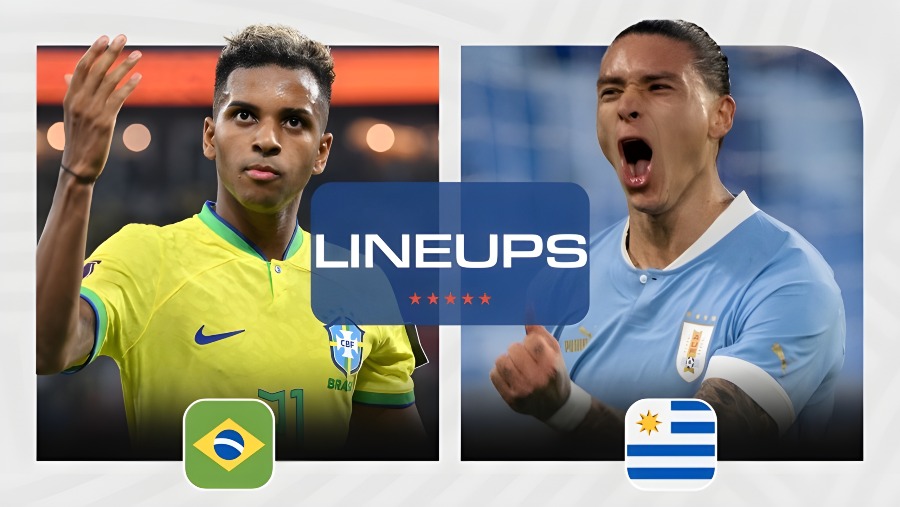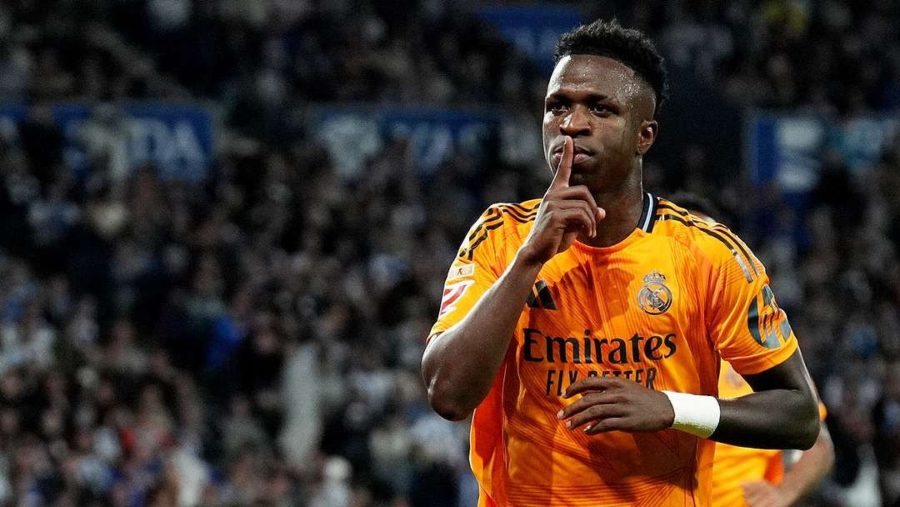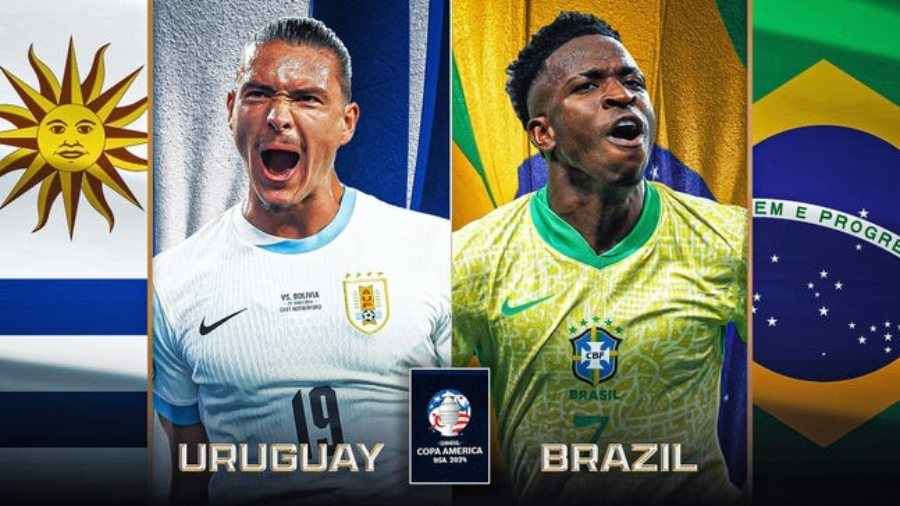On November 19, 2024, Brazil and Uruguay locked horns in a pulsating World Cup qualifier, ending in a 1-1 draw. Uruguay’s Federico Valverde dazzled with a long-range strike, but Brazil’s Gerson answered with a stunning volley—his first international goal.
This clash reignited the legendary rivalry between the two South American powerhouses. From Uruguay’s 1950 “Maracanazo” triumph to Brazil’s dominance in later years, every encounter has carried historic weight and drama.
This blog unravels the strategies and players that shaped this match. Discover the formations, standout performers, and tactical duels that make this rivalry unforgettable. Dive into the passion, skill, and fierce competition that define Brazil versus Uruguay—a saga of footballing excellence.
Historical Overview Uruguay vs Brazil National Team Matches
The football rivalry between Uruguay and Brazil, known as “El Clásico del Río Negro,” stands as a cornerstone of South American football heritage. Since their inaugural meeting in 1916, their encounters have epitomized passion, drama, and unforgettable moments.
Key Matches:
1950 World Cup Final (Maracanazo): A moment etched in history, Uruguay shocked the world with a 2-1 victory over Brazil at the Maracanã, claiming their second World Cup title and leaving the Brazilian faithful heartbroken.
1970 World Cup Semi-final: Brazil turned the tide, defeating Uruguay 3-1 en route to their third World Cup title, showcasing the brilliance of Pelé and his golden generation.
1995 Copa América Final: On home soil, Uruguay edged Brazil in a dramatic penalty shootout, claiming the continental crown after a 1-1 draw.
Each match adds depth to a rivalry steeped in legacy and footballing greatness.
Head-to-Head Statistics
As of their latest encounter in November 2024, Brazil and Uruguay have faced each other 81 times. Brazil leads with 38 wins, Uruguay has secured 21 victories, and 22 matches have ended in draws. Brazil scored 134 goals, while Uruguay scored 94.
| Statistic | Brazil | Uruguay |
|---|---|---|
| Wins | 38 | 21 |
| Draws | 22 | 22 |
| Goals Scored | 143 | 101 |
Competition Breakdown
| Competition | Matches | Brazil Wins | Uruguay Wins | Draws | Brazil Goals | Uruguay Goals |
|---|---|---|---|---|---|---|
| FIFA World Cup | 2 | 1 | 1 | 0 | 4 | 3 |
| World Cup Qualifiers | 10 | 4 | 1 | 5 | 20 | 11 |
| Copa América | 26 | 9 | 9 | 8 | 37 | 40 |
| FIFA Confederations Cup | 1 | 1 | 0 | 0 | 2 | 1 |
| International Friendlies | 42 | 23 | 10 | 9 | 80 | 46 |
These statistics highlight the competitive nature of the Brazil-Uruguay rivalry, with both teams achieving significant victories over the years.
Recent Encounters
| Date | Competition | Result |
|---|---|---|
| Nov 19, 2024 | World Cup Qualifier | Brazil 1-1 Uruguay |
| Jul 6, 2024 | Copa América Quarter-final | Uruguay 0-0 Brazil (4-2 on penalties) |
| Oct 17, 2023 | World Cup Qualifier | Uruguay 2-0 Brazil |
These recent matches have further intensified the rivalry, showcasing both teams’ strategic prowess and competitive spirit.
Iconic Matches
The timeline above highlights some of the most iconic matches in the Brazil vs Uruguay rivalry, showcasing pivotal moments that have defined their competitive history.
Current Lineup Comparison and Key Players

Brazil’s Starting Lineup (4-2-3-1)
Brazil’s recent performances have been mixed, including a 1-1 draw against Venezuela in November 2024, where they dominated possession but failed to secure a win.
| Position | Player | Club |
|---|---|---|
| Goalkeeper | Ederson | Manchester City |
| Right Back | Danilo (Captain) | Juventus |
| Center Back | Marquinhos | Paris Saint-Germain |
| Center Back | Gabriel Magalhães | Arsenal |
| Left Back | Abner Vinícius | Real Betis |
| Midfielder | Gerson | Olympique Marseille |
| Midfielder | Bruno Guimarães | Newcastle United |
| Midfielder | Savinho | PSV Eindhoven |
| Forward | Raphinha | FC Barcelona |
| Forward | Vinícius Júnior | Real Madrid |
| Forward | Igor Jesus | Shakhtar Donetsk |
Uruguay’s Starting Lineup (4-3-3)
Under the guidance of coach Marcelo Bielsa, Uruguay has demonstrated impressive form in recent matches, notably securing a thrilling 3-2 victory over Colombia in November 2024.
| Position | Player | Club |
|---|---|---|
| Goalkeeper | Sergio Rochet | Nacional |
| Right Back | Guillermo Varela | Flamengo |
| Center Back | José María Giménez | Atlético Madrid |
| Center Back | Mathías Olivera | Napoli |
| Left Back | Marcelo Saracchi | Levante UD |
| Midfielder | Rodrigo Bentancur | Tottenham Hotspur |
| Midfielder | Manuel Ugarte | Paris Saint-Germain |
| Midfielder | Federico Valverde | Real Madrid |
| Forward | Facundo Pellistri | Manchester United |
| Forward | Darwin Núñez | Liverpool |
| Forward | Maximiliano Araújo | Club América |
Side-by-Side Comparison:
| Position | Uruguay Player | Brazil Player |
|---|---|---|
| Goalkeeper | Sergio Rochet | Ederson |
| Right Back | Guillermo Varela | Danilo |
| Center Back | José María Giménez | Marquinhos |
| Center Back | Mathías Olivera | Gabriel Magalhães |
| Left Back | Marcelo Saracchi | Abner Vinícius |
| Midfielder | Rodrigo Bentancur | Bruno Guimarães |
| Midfielder | Manuel Ugarte | Gerson |
| Midfielder | Federico Valverde | Savinho |
| Forward | Facundo Pellistri | Raphinha |
| Forward | Darwin Núñez | Vinícius Júnior |
| Forward | Maximiliano Araújo | Igor Jesus |
| Right Wing | Facundo Pellistri | Raphinha |
| Striker | Darwin Núñez | Igor Jesus |
| Left Wing | Maximiliano Araújo | Vinícius Júnior |
Tactical Breakdown
Uruguay’s Style of Play:
Under Marcelo Bielsa, Uruguay thrives on a disciplined defensive setup and lightning-fast counterattacks. Their 4-3-3 formation morphs into a 4-5-1 when defending, ensuring tight defensive lines and minimal central spaces for opponents. Full-backs Guillermo Varela and Mathías Olivera prioritize defense before venturing forward, while midfielders like Rodrigo Bentancur and Manuel Ugarte excel in breaking up plays and launching counters. Offensively, Uruguay leverages the pace of Darwin Núñez and Facundo Pellistri, striking decisively during transitions—a hallmark of their recent performances.
Brazil’s Approach:
Brazil’s signature attacking flair combines intricate passing, creativity, and relentless pressing. Their 4-2-3-1 formation capitalizes on wingers like Raphinha and Vinícius Júnior, who stretch defenses and create scoring chances. Midfielders such as Bruno Guimarães and Gerson provide balance, blending defensive resilience with playmaking. Defensively, Brazil applies high pressing, forcing turnovers and maintaining control—a strategy evident in their dominant possession and pressure in recent games.
Potential Game-Changing Duels:
- Darwin Núñez (Uruguay) vs. Marquinhos (Brazil): Núñez’s speed and physicality will test Marquinhos’s positioning and composure, potentially shaping Uruguay’s counterattacking success.
- Federico Valverde (Uruguay) vs. Bruno Guimarães (Brazil): The battle for midfield supremacy hinges on Valverde’s dynamism and Guimarães’s creativity, dictating the game’s tempo.
- Raphinha (Brazil) vs. Mathías Olivera (Uruguay): Raphinha’s dribbling flair against Olivera’s defensive tenacity could be decisive in Brazil’s quest to breach Uruguay’s left flank.
Win-Loss Ratio Between Brazil and Uruguay

The win-loss ratio between Brazil and Uruguay highlights their intense rivalry, reflecting decades of competitive and historic football clashes.
The win-loss ratio between Brazil and Uruguay underscores the enduring intensity of their rivalry, promising more thrilling encounters ahead.
Player Performances:
This showcases individual brilliance, highlighting key contributions, decisive moments, and the impact of star players on pivotal matches.
This analysis of player performances emphasizes their crucial role in shaping match outcomes, leaving fans eager for their next display.
Historical Lineup Comparison
The football rivalry between Uruguay and Brazil has produced several iconic matches, notably the 1950 FIFA World Cup final and the 1995 Copa América final. Analyzing the lineups from these encounters reveals the evolution of tactics and player roles over the decades.
1950 FIFA World Cup Final (Maracanazo):
Date: July 16, 1950
Result: Uruguay 2-1 Brazil
Lineups:
| Position | Uruguay Player | Brazil Player |
|---|---|---|
| GK | Roque Máspoli | Moacir Barbosa |
| RB | Matías González | Augusto (c) |
| CB | Eusebio Tejera | Juvenal |
| CB | Víctor Rodríguez Andrade | Bigode |
| LB | Juan Carlos González | Bauer |
| RM | Obdulio Varela (c) | Danilo |
| CM | Schubert Gambetta | Jair |
| LM | Alcides Ghiggia | Friaça |
| RF | Juan Alberto Schiaffino | Zizinho |
| CF | Óscar Míguez | Ademir |
| LF | Rubén Morán | Chico |
Formation Analysis:
Uruguay employed a **2-3-5** formation, common at the time, focusing on a strong forward line. Brazil mirrored this setup but faced challenges in defense, leading to Uruguay’s comeback victory.
1995 Copa América Final:
Date: July 23, 1995
Result: Uruguay 1-1 Brazil (Uruguay won 5-3 on penalties)
Lineups:
| Position | Uruguay Player | Brazil Player |
|---|---|---|
| GK | Fernando Álvez | Cláudio Taffarel |
| RB | Gustavo Méndez | Jorginho |
| CB | José Herrera | Aldair |
| CB | Eber Moas | André Cruz |
| LB | Tabaré Silva | Roberto Carlos |
| RM | Álvaro Gutiérrez | César Sampaio |
| CM | Diego Dorta | Dunga (c) |
| LM | Gustavo Poyet | Zinho |
| RF | Enzo Francescoli (c) | Túlio |
| CF | Facundo Pellistri | Edmundo |
| LF | Maximiliano Araújo | Juninho Paulista |
Formation Analysis:
Both teams adopted a **4-4-2** formation, reflecting a shift towards balanced play with emphasis on midfield control. The match was tightly contested, culminating in a penalty shootout.
Evolution of Tactics and Player Roles:
- 1950s Era: The **2-3-5** formation prioritized offensive play, with five forwards aiming to overwhelm defenses. Midfielders served as a link between defense and attack, while defenders focused primarily on man-marking.
- 1990s Era: The transition to **4-4-2** formations indicated a move towards balance between attack and defense. Midfielders had dual responsibilities, contributing to both defensive duties and offensive support. Full-backs like Roberto Carlos became more involved in attacking plays, showcasing the evolution of the role.
Past vs. Present Lineup Analysis:
| Aspect | 1950 Lineups | 1995 Lineups | Modern Lineups |
|---|---|---|---|
| Formation | 2-3-5 | 4-4-2 | 4-3-3 / 4-2-3-1 |
| Defensive Strategy | Man-marking | Zonal marking | High-pressing, offside traps |
| Midfield Role | Transitional link | Dual-role (defense and attack) | Playmaking, controlling tempo |
| Forward Play | Multiple forwards (5) | Strike partnerships (2) | Versatile front three |
The evolution from aggressive forward-heavy formations to balanced and versatile setups reflects the strategic advancements in football, allowing teams to adapt to modern playstyles and competitive demands.
Historical Lineup Comparison
The football rivalry between Uruguay and Brazil has produced several iconic matches, notably the 1950 FIFA World Cup final and the 1995 Copa América final. Analyzing the lineups from these encounters reveals the evolution of tactics and player roles over the decades.
1950 FIFA World Cup Final (Maracanazo):
Date: July 16, 1950
Result: Uruguay 2-1 Brazil
Lineups:
| Position | Uruguay Player | Brazil Player |
|---|---|---|
| GK | Roque Máspoli | Moacir Barbosa |
| RB | Matías González | Augusto (c) |
| CB | Eusebio Tejera | Juvenal |
| CB | Víctor Rodríguez Andrade | Bigode |
| LB | Juan Carlos González | Bauer |
| RM | Obdulio Varela (c) | Danilo |
| CM | Schubert Gambetta | Jair |
| LM | Alcides Ghiggia | Friaça |
| RF | Juan Alberto Schiaffino | Zizinho |
| CF | Óscar Míguez | Ademir |
| LF | Rubén Morán | Chico |
Formation Analysis:
Uruguay employed a **2-3-5** formation, common at the time, focusing on a strong forward line. Brazil mirrored this setup but faced challenges in defense, leading to Uruguay’s comeback victory.
1995 Copa América Final:
Date: July 23, 1995
Result: Uruguay 1-1 Brazil (Uruguay won 5-3 on penalties)
Lineups:
| Position | Uruguay Player | Brazil Player |
|---|---|---|
| GK | Fernando Álvez | Cláudio Taffarel |
| RB | Gustavo Méndez | Jorginho |
| CB | José Herrera | Aldair |
| CB | Eber Moas | André Cruz |
| LB | Tabaré Silva | Roberto Carlos |
| RM | Álvaro Gutiérrez | César Sampaio |
| CM | Diego Dorta | Dunga (c) |
| LM | Gustavo Poyet | Zinho |
| RF | Enzo Francescoli (c) | Túlio |
| CF | Facundo Pellistri | Edmundo |
| LF | Maximiliano Araújo | Juninho Paulista |
Formation Analysis:
Both teams adopted a **4-4-2** formation, reflecting a shift towards balanced play with emphasis on midfield control. The match was tightly contested, culminating in a penalty shootout.
Evolution of Tactics and Player Roles:
- 1950s Era: The **2-3-5** formation prioritized offensive play, with five forwards aiming to overwhelm defenses. Midfielders served as a link between defense and attack, while defenders focused primarily on man-marking.
- 1990s Era: The transition to **4-4-2** formations indicated a move towards balance between attack and defense. Midfielders had dual responsibilities, contributing to both defensive duties and offensive support. Full-backs like Roberto Carlos became more involved in attacking plays, showcasing the evolution of the role.
Past vs. Present Lineup Analysis:
| Aspect | 1950 Lineups | 1995 Lineups | Modern Lineups |
|---|---|---|---|
| Formation | 2-3-5 | 4-4-2 | 4-3-3 / 4-2-3-1 |
| Defensive Strategy | Man-marking | Zonal marking | High-pressing, offside traps |
| Midfield Role | Transitional link | Dual-role (defense and attack) | Playmaking, controlling tempo |
| Forward Play | Multiple forwards (5) | Strike partnerships (2) | Versatile front three |
The evolution from aggressive forward-heavy formations to balanced and versatile setups reflects the strategic advancements in football, allowing teams to adapt to modern playstyles and competitive demands.
Conclusion
The Brazil-Uruguay rivalry transcends football, embodying history, passion, and fierce competition. Brazil’s attacking flair meets Uruguay’s disciplined defense under Marcelo Bielsa in a clash of tactical brilliance.
Key battles, from midfield duels to set-piece dominance, will define the outcome. With global fans eagerly anticipating the match, one thing is certain—this showdown will add another thrilling chapter to football’s storied rivalry.

